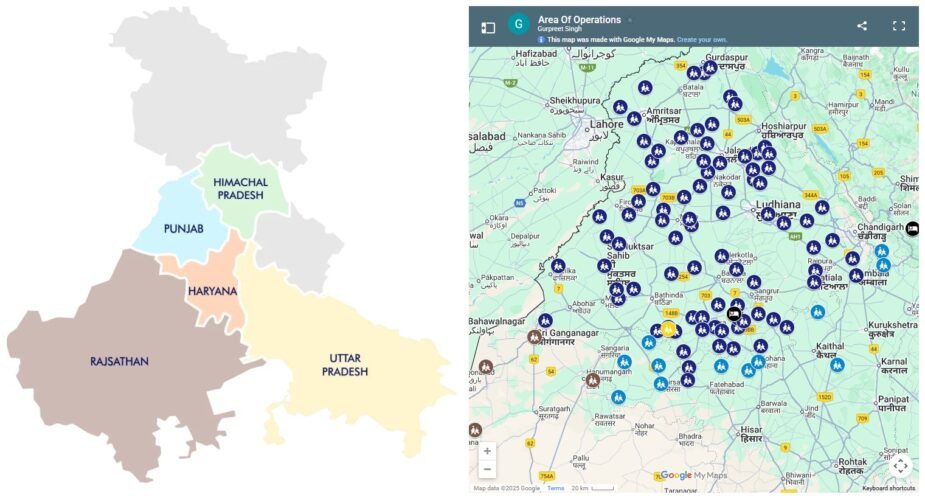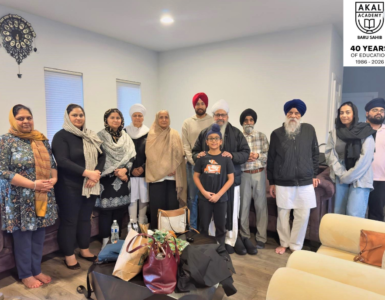In India’s vast and diverse landscape, where vibrant cities intersect with peaceful villages, education remains the great equalizer. However, millions of children in rural India still face significant barriers to quality education. As we move through 2025, the state of rural education shows both progress and ongoing challenges. With over 60% of India’s population living in rural areas, improving access to quality rural schooling is crucial—not only as a social responsibility but also as a driver of sustainable development, poverty reduction, and national cohesion.
This article explores the current landscape of rural education in India, exposing the stark urban-rural educational divide, identifying key challenges, and highlighting promising initiatives like those by Akal University. Discover how Akal Academies deliver quality, affordable education to children from economically weaker families—transforming rural lives and narrowing the education gap.
The Current Landscape: A Snapshot of Rural Education in 2025
India loves to celebrate its education success stories. The government proudly talks about the Right to Education (RTE) Act, Samagra Shiksha Abhiyan, Mid-Day Meals, DIKSHA, and NEP 2020. On paper, everything looks perfect. Reports say 98% of children are in school. Dropout rates have fallen. Meals are served. Teachers are trained. Digital classes are running.
But walk into a village school. The story changes.
Yes, 1.2 million rural schools exist—according to UDISE+ 2024. But many are just buildings with no life inside.
A school may show “100% enrollment”—yet half the children come only for the free meal, then leave. The register says “teacher present” – but often, the teacher is on leave, or one teacher manages five classes.
The ASER 2024 report says it clearly: Only 23% of Class 3 children in rural areas can read a Class 2 story. Just 33% can do simple subtraction. These are not old numbers. This is 2025.
The Mid-Day Meal brings children to school – but does it keep them learning?
A hot meal fills the stomach, but not the mind. Many children sit, eat, and go home—without understanding a single lesson.
DIKSHA claims to train 1.5 million rural teachers. But how many actually use it? In villages with no electricity or internet, a phone with 2G is the only “digital tool.”
The November 2024 Lok Sabha reply admits only 44.9% of rural schools have internet.
Smart classrooms? – Mostly locked rooms with broken computers.
NEP 2020 speaks of vocational skills and mother-tongue teaching. Beautiful words. But in reality, a child in a Bihar village still learns English by roti, without understanding. Vocational labs? Missing. Local language books? Hardly available.
Dropout rates are “down to 5-7%” at the primary level—on paper. But talk to parents. By Class 8, 15% have quietly vanished—especially girls. They are needed at home. Or the school is too far. Or there’s no toilet.
The truth is simple: Government data shows progress on paper. Ground reality shows pain.
A child’s name is on the roll.
But is the child learning?
Is the teacher teaching?
Is the school even open?
That’s the real question rural India is asking in 2025.
The Urban-Rural Education Gap in India: A Major Challenge for 2025
Rural education is the backbone of India’s future, but the wide urban-rural education divide remains a significant challenge. Urban schools, mostly private and fee-based, feature world-class amenities like air-conditioned classrooms, high-speed Wi-Fi, advanced science labs, and diverse extracurricular programs. In metropolitan cities such as Mumbai and Delhi, annual school fees often exceed ₹2-5 lakh per child, reflecting demand for global exposure and better college placement opportunities. According to UDISE+ 2024, 95% of urban schools have access to functional toilets, electricity, and clean drinking water.
Rural schools in India face significant challenges with limited infrastructure and overcrowded classrooms. Many operate from simple structures lacking basic amenities like clean drinking water and separate toilets for girls, affecting safety and attendance. Electricity supply is often unreliable, impacting learning opportunities, especially for digital education. Teacher shortages create high student-teacher ratios, reducing personalized attention and affecting education quality. These conditions underscore the urgent need to improve rural educational facilities to ensure safer, more inclusive, and effective learning environments for all students in India’s villages.
This gap transcends infrastructure; it is economic and opportunity-driven. High costs of urban education exclude many rural and lower-income families, widening inequality. Recent studies show the urban-rural learning gap drains India’s productivity, costing billions in untapped potential yearly. Rural students typically score significantly lower on national assessments like NAS 2021, limiting their access to higher-paying jobs in tech, finance, and governance fields. Consequently, this brain drain weakens rural economies and perpetuates poverty cycles.
Addressing this deep educational divide demands targeted government investments, policy reforms, and community-driven initiatives. Innovative examples, Rural Education Models by Akal University and Eternal University blending tradition with modern technology, highlight pathways to bridging the educational gap and fostering inclusive growth.
Key Challenges Holding Rural Education Back in India 2025
Despite policy efforts, rural education in India faces multiple complex challenges in 2025. Infrastructure problems top the list. Despite progress, a report from the government shows 28% of rural schools lack usable girls’ toilets, with many facing unreliable electricity and missing libraries—creating unsafe, uninspiring spaces for learning. Many children walk long distances through muddy paths just to reach broken or worn-down school buildings.
Teacher shortages worsen the crisis. India faces over 1 million teacher vacancies, with rural schools hardest hit—some operate with a single teacher for all grades. Low salaries (₹20,000-30,000/month compared to urban ₹50,000+) and remote postings discourage skilled teachers, resulting in untrained and overworked staff. Language barriers also affect learning, as many rural children speak local dialects and struggle with Hindi or English-medium teaching.
Socio-economic factors like poverty and gender bias fuel high dropout rates, especially among girls in villages. Rural female literacy lags well behind male literacy, holding families back from breaking free of hardship. The digital divide runs deep, with only 18.47% of rural schools having internet access as compared to 47.47% in urban schools, leaving rural children cut off from online learning tools and widening the education gap.
Old-fashioned school programs do not prepare students for today’s jobs. Practical training and skill-building are scarce, leaving graduates unprepared for India’s growing part-time or freelance work opportunities. These challenges call for comprehensive, well-rounded solutions—examples of which are seen in Akal University’s innovative rural education programs.
Akal University and Eternal University: Leading the Change in Rural Education
Amid the many challenges facing rural education, Akal University and Eternal University, founded by the visionary The Kalgidhar Trust—stands as a powerful example of transformation.
Since opening its first school in Baru Sahib, Himachal Pradesh in 1988 with only five students, the institution has expanded to 130 Akal Academies across Punjab, Rajasthan, Haryana, Uttar Pradesh, and Himachal Pradesh.
These schools now educate over 75,000 students, with 70% being first-generation learners from economically weak families. Most students (around 32331) are been provide with free education.
Akal Academies are known for their focus on value-based education, combining CBSE/IB course content with Sikh values such as empathy, honesty, and social responsibility. This balanced approach is practical and effective.
The student-teacher ratio is a commendable 20:1, better than the typical CBSE ratio of 30:1. Additionally, economically weak students receive fee concessions based on family income, and fee increases are kept low, making education affordable and accessible.
The schools encourage innovative learning methods. Homework is completed during the last hour of school, freeing students from the burden of carrying heavy bags home. This also helps because many parents are not educated enough to support their children with homework. This approach reduces stress and keeps students motivated.
The Universities operate on a self-sustaining financial model: fees cover operational costs, and larger schools with over 800 students help fund new academies, enabling growth without constant reliance on donations. Partnerships like the one with YUVA Unstoppable have helped over many rural students across 19 districts develop skills and continue their education.
Akal University also prioritizes girls’ education, with female enrollment at 50%, supported by safe hostels and protective measures. In the 2023-24 academic year, Akal students achieved 13 district topper positions in CBSE exams, breaking long-held assumptions about rural education. This is not charity; it is empowerment, proving that quality education can flourish in rural areas.
Success Stories: From Village Classrooms to IAS Glory
Akal Academies are not just building schools; they are creating future leaders.
Take the example of Jaspinder Singh, son of a farmer from Muktsar Sahib, Punjab. Growing up in a simple home, Jaspinder attended Akal Academy Sri Muktsar Sahib, where dedicated teachers inspired his passion for public service. Despite many challenges, he cleared the UPSC exam in 2024, earning an All India Rank (AIR) of 33. He credits the academy’s supportive environment and lessons on resilience and values for his success. Today, as an IAS officer in Sangrur, Jaspinder mentors rural youth, fulfilling the dream of founder Sant Baba Iqbal Singh Ji to prepare civil servants for nation-building.
Jaspinder is not alone. Simrandeep Singh from Akal Academy Kauriwara secured AIR 34, while Harjinder Singh of Akal Academy Bharyal Lahri achieved AIR 815—making Jaspinder the third IAS officer from this network. Beyond the civil services, Akal alumni excel in various fields: more than 60 graduates work as doctors and engineers, such as Arshdeep Singh, a B.Tech graduate from a village in Uttar Pradesh. Athletes like Sahil, who trained on simple village grounds, have represented India in the 100-meter race.
These success stories extend further.
Govindnoor Kaur, a celebrated fencer from rural Punjab, balanced academics and sports at Akal Academy Teja Singh Wala to win international medals. Jasjot Singh from Dakra Sahib qualified for the Rashtriya Military School without coaching. At the 2025 State Level Chhatra Samman Samaroh, Akal academies won multiple awards for academic excellence, inspiring thousands. These examples are proof of Akal’s winning formula: affordable education combined with strong values and innovation unlocks limitless potential.
Empowering Rural India: From Village Dreams to National Change in 2025
Rural education in India is at an important moment in 2025. Most children are enrolled in schools, but quality learning and equal opportunities remain out of reach for many. The gap between urban and rural schools—in facilities, teachers, and growth chances—is still wide and troubling. However, student’s stories from the 130 Akal Academies and Universities run by the Kalgidhar Trust offer hope, where children of farmers become IAS officers and engineers.
Jaspinder’s journey from a small Punjab village to All India Rank 33 in the UPSC exam shows that good education, based on strong values and support, can transform lives—even in the most remote areas.
Imagine if every rural child had the same chance as a city child—education that is free, safe, and encouraging. Achieving this requires all of us. Support a school, share these stories, raise your voice.
Because when a child from a village succeeds, India succeeds.
What will you do to support rural education? Share your thoughts below, and let us build a brighter future together.
Kalgidhar Trust: Where every rural child’s dream takes flight and every village finds hope.
















Add comment